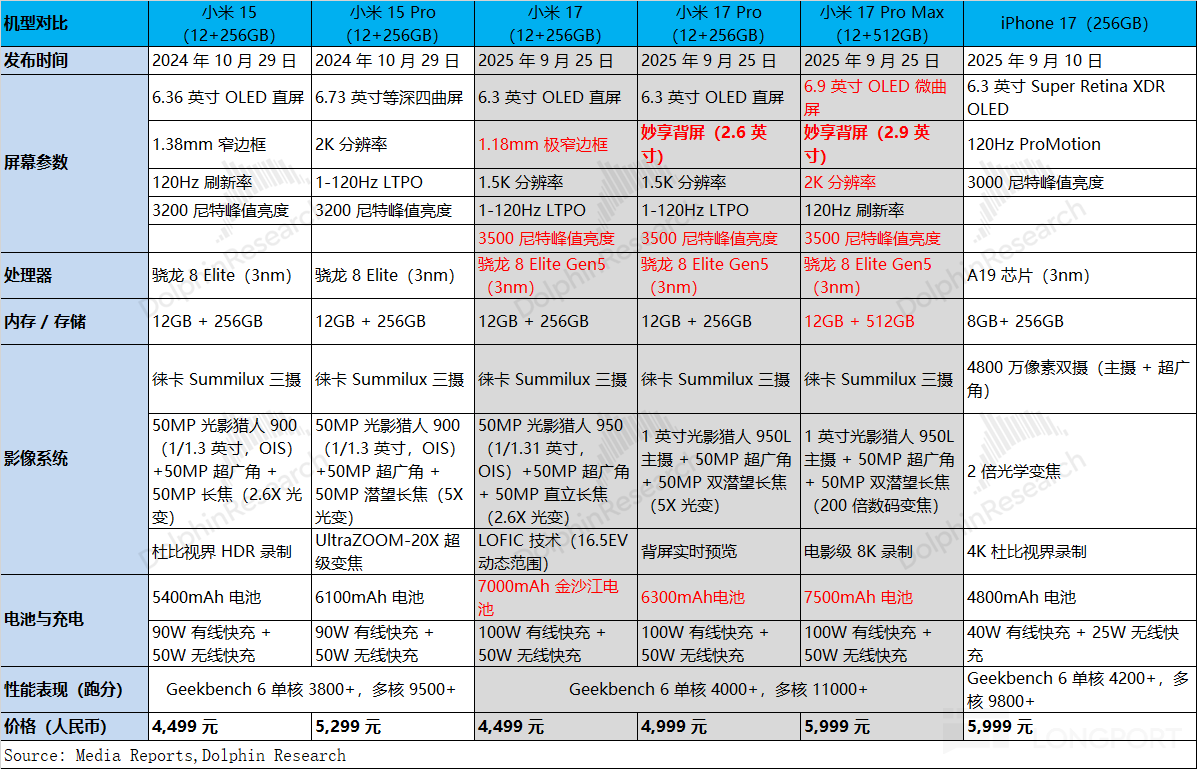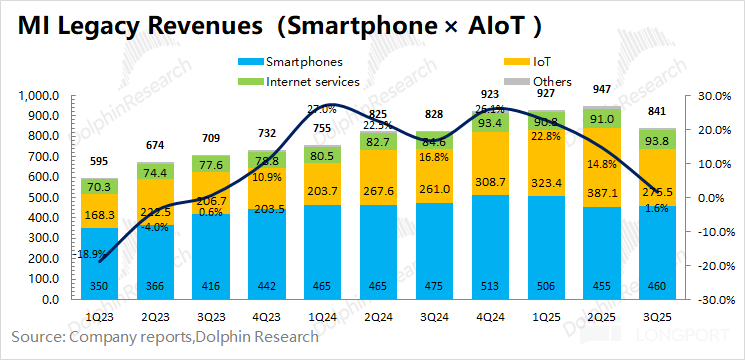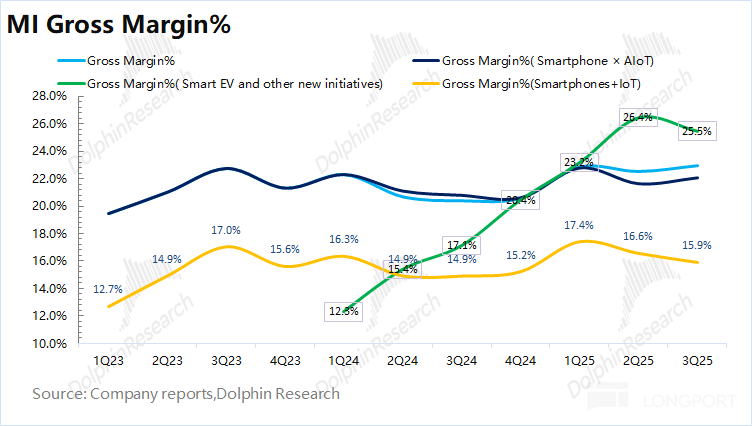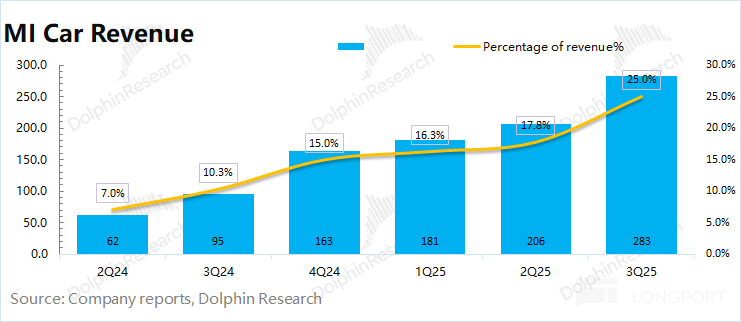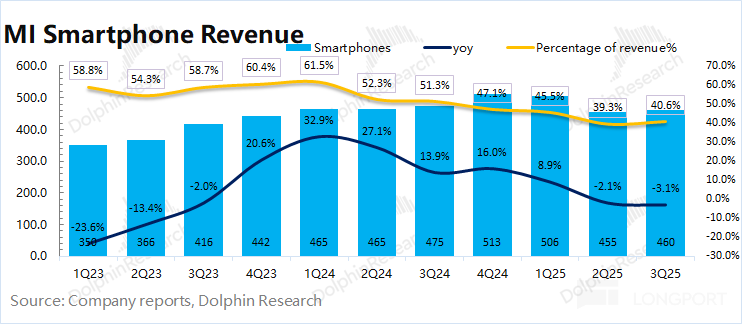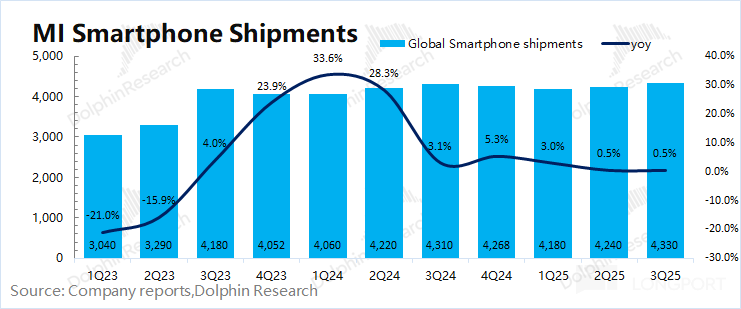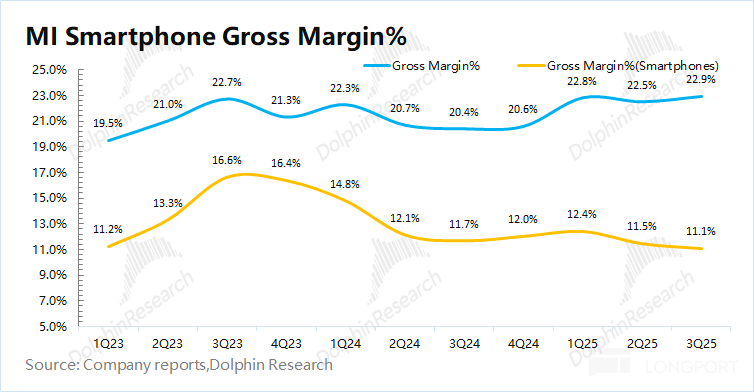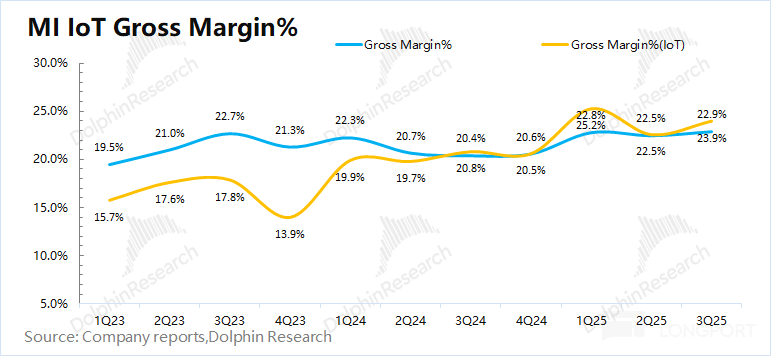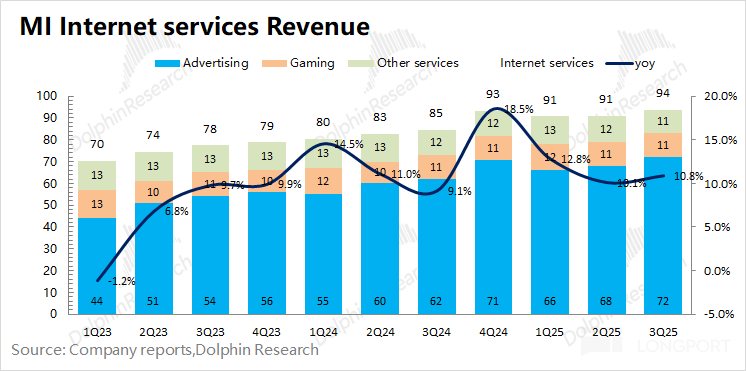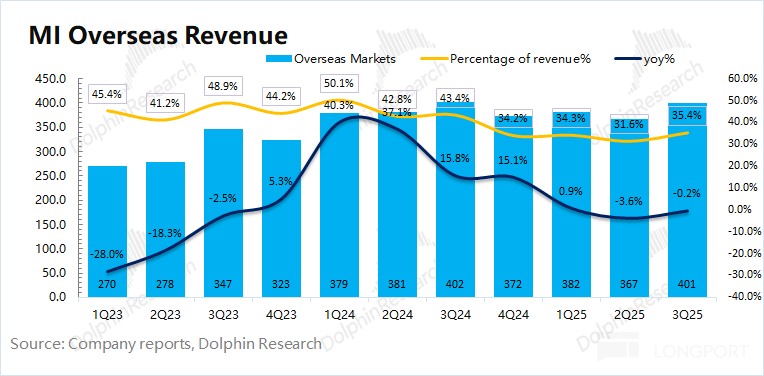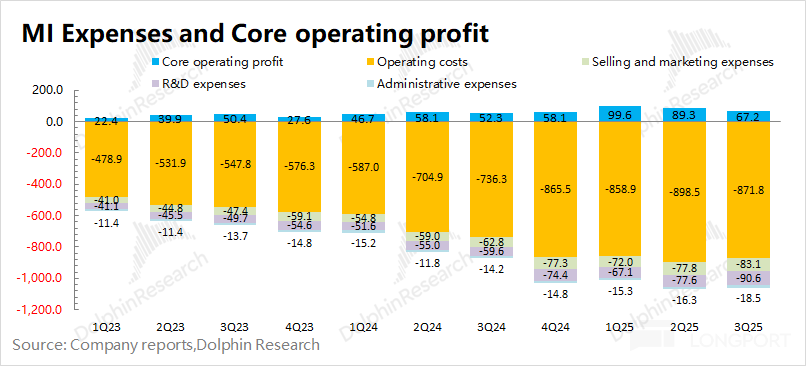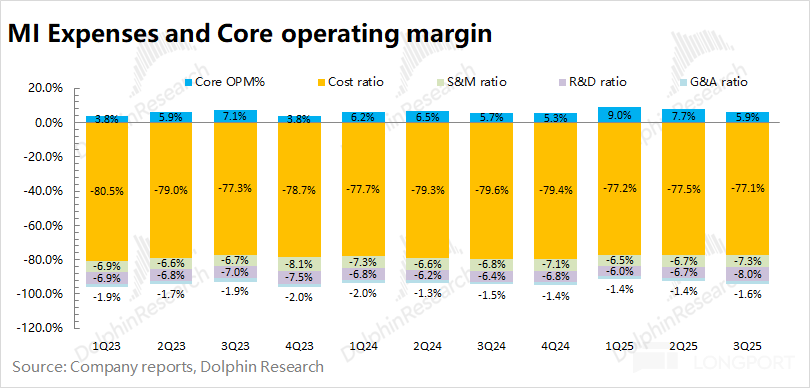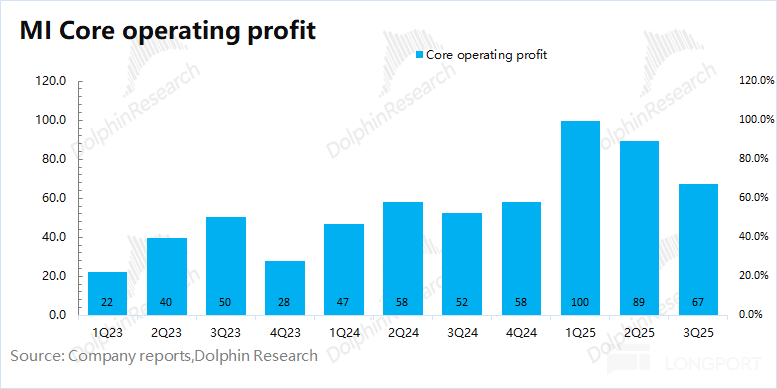
Xiaomi: With subsidies withdrawn, can the automotive sector truly uphold its reputation?

Xiaomi Group (1810.HK) released its Q3 2025 financial report (ending September 2025) after the Hong Kong stock market closed on the evening of November 18, 2025, Beijing time. The key points are as follows:
1. Overall Performance:$XIAOMI-W(01810.HK) Revenue of 113.1 billion, up 22.3% year-on-year, with traditional business (mobile x AIoT) revenue growing only 1.6% year-on-year. The growth this quarter was mainly driven by the automotive business.
Gross margin increased to a relatively high level of 22.9%, mainly supported by the structural boost from the increased proportion of the automotive business, while the gross margin of the mobile business declined due to intensified competition.
2. Automotive Business:$Xiaomi Corporation(XIACY.US) Automotive-related revenue this quarter was 29 billion yuan, basically in line with expectations. The company shipped 109,000 vehicles this quarter, with the average price per vehicle further increasing to 260,000 yuan. This was mainly due to the increased shipments of the relatively high-priced YU7, structurally driving up the average price of vehicles.
The gross margin of the automotive business continued to rise to 25.5% this quarter, with market expectations at 25.6%. However, it slightly declined from the previous quarter, mainly due to the reduced proportion of the high-margin SU7 Ultra. Dolphin Research estimates the core operating profit of Xiaomi's automotive business this quarter to be 680 million yuan (11 billion disclosed in the financial report, excluding 400 million related to equity incentives), achieving profitability for the first time.
3. Mobile: 46 billion, down 3.1% year-on-year, in line with market expectations of 45.8 billion. Xiaomi's mobile shipments grew 0.5% year-on-year this quarter, while the average price of Xiaomi phones fell 3.6% year-on-year. Under the impact of market competition, the gross margin of the mobile business continued to decline to 11.1% this quarter.
By market: Xiaomi's mobile shipments in the domestic market fell 1.8% year-on-year, while overseas market shipments grew 2.7%. With the tightening of state subsidies, Xiaomi's mobile shipments and market share in the domestic market declined year-on-year again. If storage prices continue to rise, the mobile business will face pressure not only on sales but also on gross margins.
4. IoT: 27.6 billion, up 5.6% year-on-year, market expectations 38.1 billion. The growth rate of IoT has significantly slowed down (over 40% year-on-year growth in the first three quarters), mainly due to the drag from the decline in major appliances this quarter.
Due to the relatively high unit price of major appliances, some products may have subsidies reaching 1,000-2,000 yuan. Therefore, after the tightening of subsidies, the demand for major appliance business was directly affected.
5. Internet Services: 9.4 billion, up 10.8% year-on-year, market expectations 9.2 billion. The growth was mainly driven by the advertising business, while value-added services slightly declined quarter-on-quarter. MIUI users grew 8% year-on-year, while ARPU value increased by only 2%.
By region: Overseas internet revenue this quarter was 3.3 billion yuan, while domestic internet revenue was about 6.1 billion yuan, with MIUI users continuing to grow in both domestic and overseas markets this quarter.
6. Profit: Core operating profit of main business 6.7 billion, adjusted net profit 11.3 billion (the adjustment method of net profit is not agreed upon, for reference only, no need to pay too much attention).
The core profit of Xiaomi's traditional business was about 6.03 billion yuan, and the automotive business achieved profitability for the first time with 680 million yuan. The quarter-on-quarter decline in the company's core profit this quarter was mainly due to the shrinkage of traditional business profits.

Dolphin Research's overall view: After the subsidies, what will drive growth?
The situation of Xiaomi's financial report this time has been relatively clear compared to the previous Preview, and the core operating data basically met the expectations after the previous Preview was lowered.
This financial report mainly shows the pressure on traditional business: the mobile business is facing the impact of intensified market competition, with revenue and gross margin declining this quarter; at the same time, under the "tightening of state subsidies", the growth rate of the IoT business has significantly slowed down to about 5% this quarter.
Especially in the major appliance products of the IoT business, whether there are state subsidies or not, the final payment price may differ by 1-2k or more, which directly affects the purchasing behavior of end users. Originally, major appliance products were the main driving force of the company's IoT business, and this quarter's domestic major appliance revenue even showed a double-digit decline.
Compared to this financial report, the previous continuous decline of Xiaomi's stock price from over 50 HKD to around 40 HKD actually reflects the market's dual concerns about the company's automotive business and traditional business:
a) Automotive Business: New product "vacuum period" + order decline, the supply-demand pattern may reverse next year.
Xiaomi's car deliveries in October have increased to 48,600 units, a month-on-month increase of over 6,000 units from September, benefiting from the company's previous backlog orders and the ramp-up of the second-phase factory, mainly reflecting Xiaomi's past order performance.

Compared to delivery volume, the market is more concerned about Xiaomi's current order situation. From recent order conditions, Xiaomi's weekly orders have dropped to around 4-5 thousand units, roughly corresponding to less than 20,000 new orders per month, which is actually a rather dangerous signal.
This means that the current consumption of Xiaomi's orders is faster than new orders (about 30,000 backlog orders are consumed per month), and as the "reservoir" level of Xiaomi's orders declines, the supply-demand relationship of Xiaomi's automotive business may shift from "supply shortage" to "oversupply".
Based on Xiaomi's official website reservation situation, the current delivery cycle for the basic version of Xiaomi SU7 is 28-31 weeks, SU7 Pro and SU7 Max delivery cycles are only 6-9 weeks; YU7 delivery cycle remains at 32-40 weeks.
Among them, the delivery cycle of SU7Pro and SU7Max has been shortened to delivery before the end of the year, which may be a strategy by the company to increase the overall average price of SU7 and reduce the impact of VAT subsidies on the company.
Overall, Dolphin Research estimates that the current comprehensive delivery cycle of Xiaomi's automotive business is still about 30 weeks, corresponding to nearly 400,000 orders on hand.
In the absence of new car launches by Xiaomi in the near future, if the company maintains a weekly order status of 4,000-5,000 units, combined with the ramp-up performance of the second-phase factory, Dolphin Research estimates that the company will consume the "stockpiled" orders by mid-next year, entering a demand-driven situation of "oversupply".

b) Traditional Business (Mobile xAIoT): Tightening of state subsidies and rising storage prices have lowered market expectations for the company next year.
① IoT growth has significantly slowed down: Under the promotion of state subsidy policies, the company's IoT business achieved over 40% year-on-year growth for three consecutive quarters.
As local governments adjust state subsidy policies to a "coupon grabbing or lottery" form (actually a disguised "tightening"), the year-on-year growth rate of the IoT business has significantly slowed down to single-digit growth this quarter.
[After all, state subsidies can bring a 15-20% discount, and if some consumers do not get the state subsidy qualification, they may choose not to buy or delay purchase]
The company's performance this quarter directly shattered the previous expectation of continuous high growth in the IoT business. If state subsidies continue to "tighten" next year, there is a possibility of negative growth in the IoT business based on this year's high base.

② Mobile faces pressure from rising storage prices: Xiaomi once again advanced the release of this year's flagship new product launch by more than a month, chasing Apple to release at the end of September, and fully benchmarking Apple with the names "17/17Pro/17ProMax".
However, compared to the sincerity of the iPhone17 basic version "more for the same price" (price unchanged, from 128G to 256G), Xiaomi's new phone release this time is somewhat plain.
In other words, the price of Apple's 17 new product (256G) combined with state subsidies is 5,499 yuan, narrowing the price gap with Xiaomi's flagship models, and Xiaomi did not offer a more attractive price this time.
The market was not very satisfied with this launch, and Xiaomi's stock price fell again on the day of the launch.

On the other hand, the continuous rise in storage prices directly affects next year's expectations. The increase in storage costs must either be borne by terminal manufacturers or passed on to consumers through price increases. The former will affect the company's gross margin, while the latter will affect market demand performance.
The gross margin of the company's mobile business this quarter has dropped to around 11%, and if storage prices continue to rise next year, the demand and gross margin of mobile and other electronic products will continue to be under pressure.
Overall, under the dual pressure of "traditional business + automotive business", the company's stock price has already shown frequent declines. At this stage, it is relatively more important to estimate the bottom valuation of Xiaomi after this round of decline.
In a pessimistic scenario, it is assumed that Xiaomi's traditional business will achieve single-digit growth in 2026, and the automotive business will end the "supply shortage" situation in the second half of the year. It is estimated that the core operating profit after tax of the company's traditional business in 2026 will be about 30 billion yuan; the revenue of the automotive business will be about 220 billion yuan.
Considering the pessimistic valuation, traditional business is given 15xPE (historical range is about 15-25xPE) and automotive business 1.2xPS, roughly corresponding to 850 billion HKD (assuming HKD/RMB=0.915), which is around 33 HKD/share. Some funds have some faith in Xiaomi, and it is not ruled out that funds will choose to enter early.
Overall, Xiaomi is currently under multiple negative impacts, and the mobile new product has already been released, and the automotive new product release has entered a "vacuum period", which is difficult to inject confidence into the market in the short term.
In the case of frequent declines, the main focus is on grasping the bottom valuation. Based on a pessimistic scenario, Dolphin Research estimates that the bottom range of Xiaomi's stock price is about 30-35 HKD, and it is not ruled out that funds will enter early. If the company's stock price further falls to around 30 HKD, Xiaomi's safety cushion will gradually become apparent.
The following is Dolphin Research's specific analysis of Xiaomi's financial report:
I. Overall Performance: Automotive Business as the Main Driver
With the addition of the automotive business, Xiaomi's financial report now includes not only the previous "mobile x AIoT" but also the newly added "automotive and innovative business" categories.
Xiaomi has separately disclosed "automotive and innovative business", which is enough to show the company's emphasis on the automotive business. The company's market value can break the trillion ceiling, mainly due to the expectations brought by the automotive business, which is also the key factor for the company's further breakthrough in the future.
1.1 Revenue
Xiaomi Group's total revenue for the third quarter of 2025 was 113.1 billion yuan, an increase of 22.3% year-on-year, with market expectations of 112.5 billion yuan. The company's growth this quarter mainly came from the automotive business.
1) Original business - mobile x AIoT business (traditional business) achieved revenue of 84.1 billion yuan, an increase of 1.6% year-on-year. Among them, the hardware business performed weakly, with the mobile business continuing to decline year-on-year, and the IoT business growth rate falling to single digits;
2) This quarter, Xiaomi's smart automotive and other new businesses achieved revenue of 29 billion yuan, with both shipment volume and average price increasing, mainly driven by the mass production ramp-up of YU7.


1.2 Gross Margin
Xiaomi Group's gross margin for the third quarter of 2025 was 22.9%, with market expectations of 22.7%. Among them, the gross margin of the mobile business declined again this quarter, and the automotive business was the largest contributor to the increase in gross margin.
a) Xiaomi's old business gross margin was 22.1%, with the gross margin of the mobile business declining quarter-on-quarter due to intensified market competition.
In addition, other businesses in the company's traditional business continued to incur a gross loss of 350 million yuan this quarter, including services related to air conditioning installation. If this part of the gross loss is included in the IoT business, the real gross margin of IoT should be around 22.7%.
2) The gross margin of automotive and other new businesses was 25.5%, with market expectations of 25.6%. The gross margin of the automotive business declined quarter-on-quarter this quarter, affected by the reduced proportion of the relatively high-margin SU7 Ultra model. With the launch of YU7 and the mass production ramp-up of the second-phase factory, the gross margin of Xiaomi's automotive business is expected to rise again.
Overall, the current gross margin of Xiaomi's automotive business has exceeded that of traditional business. Driven by scale effects and gross margin improvement, the company's automotive business has already achieved profitability this quarter.

II. Automotive Business: Backlog Order Clearance in Progress
In the breakdown, the automotive business is now the top priority. First, look at the automotive business: revenue of 28.3 billion, plus automotive peripheral business, totaling 29 billion, basically in line with market expectations.
Among them, sales of 109,000 units are basically known, with an average price of 260,000 yuan, a quarter-on-quarter increase of 2.8%, driven by the mass production and shipment of the new YU7 model released by the company this year, which boosted the overall average price of vehicles.


The gross margin this quarter was 25.5%, a slight decline from the previous quarter, mainly due to the reduced proportion of the relatively high-margin SU7 Ultra this quarter, which affected the gross margin performance this quarter. However, it is believed that with the increase in YU7 mass production, the gross margin of the automotive business is still expected to rise again under the influence of scale effects.
Currently, Xiaomi's automotive business still has about 400,000 backlog orders, and it is still a "supply shortage" situation. The current focus is on the company's capacity ramp-up situation. From the delivery volume in October, the company's current total monthly capacity has reached about 50,000 units, and it is estimated that Xiaomi's automotive business is expected to reach a monthly capacity of 70,000 units by the end of 2025/early 2026, further accelerating the delivery of "backlog orders".
As the "backlog orders" are consumed, the most important indicator for Xiaomi's automotive business at present is not weekly sales but weekly orders. Currently, Xiaomi's weekly orders have decreased to only 4-5k units, which is relatively weak.
At the same time, on the supply side, as Xiaomi's automotive capacity ramps up, the delivery cycle is actually shortening, and since September, Xiaomi's weekly orders have not increased (if it were a waiting period factor, the delivery cycle should shorten, and orders should rise).
It can be seen that in the case of other car companies successively releasing new cars, the market competition faced by Xiaomi has intensified.
If Xiaomi continues to maintain a weekly order performance of 4-5K, then by mid-next year, the current "backlog orders" will be consumed. Xiaomi's automotive performance will also shift from a "supply shortage" situation to a "demand"-driven orientation.
Recently, it is a "vacuum period" for Xiaomi's new product releases, making it difficult to enter a relatively optimistic outlook. Follow-up attention should be paid to Xiaomi's new product release situation and changes in weekly orders to boost demand and confidence.
III. Mobile Business: Continued Decline
Xiaomi's smart mobile business achieved revenue of 46 billion yuan in the third quarter of 2025, down 3.1% year-on-year, mainly affected by the tightening of state subsidies and intensified competition.

Dolphin Research breaks down Xiaomi's smart mobile business into volume and price:
Volume: Xiaomi's smart mobile shipments this quarter were 43.3 million units, up 0.5% year-on-year.
By market: ① In the domestic market, under the tightening of state subsidies, Xiaomi's market share in the domestic market fell to 14.6% year-on-year, affected by intensified market competition; ② In the overseas market, Xiaomi's mobile shipments grew 2.7% year-on-year, with overseas market share remaining flat year-on-year.

Price: The average price of mobile shipments this quarter was 1,062 yuan, down 3.6% year-on-year. The higher proportion of low-priced models sold this quarter led to a structural decline in the average price of the company's mobile phones.

The gross margin of the mobile business this quarter was 11.1%, a quarter-on-quarter decline of 0.4pct, mainly due to the impact of rising costs of core components such as storage and intensified market competition. As storage prices rise, the impact on the gross margin of low-priced models will be relatively greater.

IV. IoT Business: State Subsidy Decline, Significant Slowdown in Growth
Xiaomi's IoT business achieved revenue of 27.6 billion yuan in the third quarter of 2025, up 5.6% year-on-year. Affected by the decline in state subsidies, the major appliance category in the IoT business showed a double-digit decline, directly affecting the growth performance of the IoT business.
This quarter, the IoT business saw good growth in products such as robotic vacuum cleaners, power banks, electric scooters, and wearable products.

The gross margin of the IoT business this quarter was 22.9%, a quarter-on-quarter increase of 0.4pct, driven by the increased proportion of high-margin products (such as wearable products).

V. Internet Services: Advertising Remains the Core Monetization Method
Xiaomi's internet services business achieved revenue of 9.4 billion yuan in the third quarter of 2025, up 10.8% year-on-year. The main growth driver this quarter was still advertising:
a) Advertising services: Single-quarter revenue of 7.2 billion yuan, up 16.1% year-on-year. Essentially, the core advertising scenarios occupied by Xiaomi advertising - app distribution and app pre-installation - are almost a distribution tax that major app manufacturers must pay, especially app pre-installation, which is actually strongly related to mobile shipments, and advertising is almost a passive income.
b) Value-added services: This part mainly includes game distribution, Xiaomi e-commerce - Youpin, and Xiaomi Finance, etc. This part of the revenue was about 2.2 billion yuan, down 3.6% year-on-year. Finance is dormant under macro headwinds, the discourse power of game distribution channels has declined, and Youpin e-commerce has not made much splash, so there is basically no expectation for this part of the value-added business.
Overall, this business is still long-term dependent on the revenue logic of hardware shipments. In the reclassified revenue of Xiaomi, it is generally classified as Legacy business. Only by combining software and hardware can the company, as a mobile phone manufacturer, continue to tell the logic of internet monetization. However, even if the internet business is classified as Legacy hardware business, the overall gross margin has already been surpassed by the automotive business.

VI. Overseas Market: Software Services Continue to Grow, Hardware Remains Sluggish
Xiaomi's overseas revenue in the third quarter of 2025 was 40.1 billion yuan, down 0.2% year-on-year, previously affected by the domestic market's state subsidy policy and Xiaomi's automotive breakthrough, the company mainly focused on the domestic market, with the proportion of overseas market revenue falling to about 35%.
Specifically, Xiaomi's overseas internet business grew 19.1% this quarter, reaching 3.3 billion yuan; while the company's overseas hardware revenue fell 2% year-on-year, reflecting that the demand in the overseas hardware market is still relatively weak.

VII. Profit: Automotive Business Achieves "Turnaround to Profitability" for the First Time
Xiaomi's total expenses for the third quarter of 2025 were 19.2 billion yuan, with the expense ratio rising to 17%. Part of this is due to the automotive business, with operating expenses of the automotive business continuing to increase by 6.7 billion yuan.
Excluding the automotive business, the operating expenses of the traditional business were about 12.5 billion yuan, with both year-on-year and quarter-on-quarter increases. The operating expense ratio of the traditional business increased to 14.9%, mainly due to the increase in Xiaomi Home and automotive sales stores and increased R&D investment.


The adjusted net profit for the third quarter of 2025 was 11.3 billion yuan, but Dolphin Research has always disagreed with Xiaomi's method of adjusting net profit - financial income is not adjusted out, and the dividend income of the companies it invests in is not adjusted out. However, even if these are sustainable, they are not the company's main business and cannot reflect the long-term sustainability of profitability.
Overall, Dolphin Research is more concerned with the core operating profit above (revenue - cost - three expenses), which is a more realistic indicator of the company's ability to continuously operate its main business profitably.
The actual core operating profit of the company this quarter was 6.7 billion yuan, with a core operating profit margin of 5.9%, mainly affected by the pressure on mobile gross margins and increased expenses.
Specifically, the core operating profit of the company's traditional business this quarter was about 6.03 billion yuan, and the core operating profit of the automotive business was about 680 million yuan (11 billion mentioned in the financial report, excluding 400 million in equity incentives).

<End here>
Dolphin Research Xiaomi Group Historical Article Review:
New Product Release Information
September 26, 2025, Mobile New Product Launch "Xiaomi (including Minutes): Fully Benchmarking iPhone! "More for the Same Price" Hard to the End"
July 3, 2025 "Lei Jun Symposium: Not "Rolling" Low-Priced Cars, Preparing to Go Overseas in 2027"
June 26, 2025, YU7 Launch "Xiaomi Automotive: YU7 Explosive Start, Will It Kick Tesla Off the "Altar"?"
May 22, 2025, YU7 Warm-up "Xiaomi (Minutes): "National Goods Godfather" New Car YU7 Arrives, "Foreign Monk" Model Y Really in Danger?"
Earnings Season
August 19, 2025, Conference Call "Xiaomi (Minutes): Mobile Target Lowered to 175 Million, Automotive Not Participating in Internal Roll"
August 19, 2025, Earnings Review "Xiaomi: Mobile Faces "Cold Wave" Again, Automotive "Racing" to the Rescue?"
May 27, 2025, Conference Call "Xiaomi (Minutes): Annual Mobile Target Maintained at 180 Million Units"
May 27, 2025, Earnings Review "Xiaomi: One Hand on Automotive, One Hand on State Subsidies, Really Going to "Win Big" This Time?"
March 18, 2025, Conference Call "Xiaomi (Minutes): Mobile to Watch 200 Million Units, Automotive No Strict Profit Target"
March 18, 2025, Earnings Review "Xiaomi: Claimed "Strongest Ever", Really That Impressive?"
November 18, 2024, Conference Call "Xiaomi: Target to Open 20,000 Xiaomi Homes in 2025 (24Q3 Conference Call)"
November 18, 2024, Earnings Review "Proud and Elated, "Super Xiaomi" Arrives"
August 21, 2024, Conference Call "Xiaomi: Enhancing Automotive Competitiveness, Not Participating in Price War (24Q2 Conference Call Minutes)"
August 21, 2024, Earnings Review "Automotive Burns, Mobile Warms, Is Xiaomi Returning to the Altar?"
May 23, 2024, Conference Call "Xiaomi: New Retail for Automotive, Target 20,000 Xiaomi Homes in Three Years (24Q1 Conference Call)"
May 23, 2024, Earnings Review "Xiaomi: Mobile Rebounds, Automotive Booms, Can It Really Redeem Itself?"
March 19, 2024, Conference Call "Xiaomi: Aiming to Become One of the Top Five Global Automotive Brands (4Q23 Conference Call Minutes)"
March 19, 2024, Earnings Review ""Mediocre" Xiaomi: Can Only Rely on Automotive to Tell New Stories"
November 20, 2023, Conference Call "Xiaomi Management Talks, Source of Gross Margin Improvement (3Q23 Conference Call Minutes)"
November 20, 2023, Earnings Review "Xiaomi "Kills" Back"
August 29, 2023, Conference Call "Inventory Clearance Completed, Impairment Reversal Increases Profit (Xiaomi 2Q23 Conference Call)"
August 29, 2023, Earnings Review "India Disaster, Huawei Revival, Can Xiaomi Rise Again?"
May 25, 2023, Conference Call "Investing in Chips is a Long-term Strategy Xiaomi Must Pursue (Xiaomi 23Q1 Conference Call Minutes)"
May 24, 2023, Earnings Review "Reduced Inventory, Lost Market Share, Where Does Xiaomi Go From Here?"
March 25, 2023, Conference Call "Inventory Clearance Effective, Demand Recovery Still Not Arrived (Xiaomi 22Q4 Conference Call)"
March 24, 2023, Earnings Review "Xiaomi: Fallen to the Bottom, When Can It Stand Up Again"
November 23, 2022, Conference Call "Inventory Begins to Digest, Supply and Demand Moving Towards Balance (Xiaomi 22Q3 Conference Call)"
November 23, 2022, Earnings Review "Xiaomi Lying Low for Too Long, Finally About to See "Light""
August 19, 2022, Conference Call "After a Comprehensive Decline in Earnings, How Does Management Explain (Xiaomi 22Q2 Conference Call)"
August 19, 2022, Earnings Review "Layoffs Can't Save Xiaomi's Many Predicaments"
May 19, 2022, Conference Call "Internally and Externally Troubled Xiaomi, What Does Management Say? (Xiaomi 22Q1 Conference Call)"
May 19, 2022, Earnings Review "Internal Woes and External Troubles, Xiaomi is Not the Best Choice"
March 22, 2022, Conference Call "Xiaomi Group: What Does Management Say After a Mediocre Earnings Report? (Conference Call Minutes)"
March 22, 2022, Earnings Review "Ordinary Xiaomi: Tasteless to Eat, Pity to Discard"
November 30, 2021, Conference Call "With Xiaomi Releasing Pure Electric Models Shortly After, How Does Li Auto Compete? (Meeting Minutes)"
November 23, 2021, Conference Call "Does Shortage Cause Mobile Decline? Listen to What Xiaomi Management Says (Xiaomi Conference Call)"
November 23, 2021, Earnings Review "Big Ups and Downs, Where is Xiaomi Going?"
August 26, 2021, Conference Call "Xiaomi Group: After a Beautiful Report Card, Listen to What Management Talked About"
August 25, 2021, Earnings Review "No More Doubts, Xiaomi Returns to the "Altar""
May 26, 2021, Earnings Review "Impressive Performance, Is Xiaomi Going for a Davis Double?"
March 25, 2021, Conference Call "Chip Shortage, Slow Internet/IoT, Car Manufacturing? This is How Xiaomi Answered!"
March 24, 2021, Earnings Review "The Expectation Gap is So Big It Makes You Doubt Life, What's Going on with Xiaomi?"
In-depth
December 7, 2023 "Consumer Electronics "Climbing Out of the Pit": Xiaomi Recovers, Apple Holds On"
December 1, 2022 "Xiaomi: The "Three Arrows" of a Turnaround in Adversity"
June 17, 2022 "Consumer Electronics "Ripe", Apple Holds Firm, Xiaomi Struggles"
December 1, 2021 "Honor Attacks, Xiaomi Faces Another "Life and Death Test""
November 24, 2021 "What's Really Wrong Behind Xiaomi's Deep Decline?"
June 11, 2021 "2021, Xiaomi "Reborn" | Dolphin Research"
March 16, 2021 "Dolphin Research | A Turn of Events, Is Xiaomi Finally Shaking Off Bad Luck?"
Risk Disclosure and Statement of This Article: Dolphin Research Disclaimer and General Disclosure
The copyright of this article belongs to the original author/organization.
The views expressed herein are solely those of the author and do not reflect the stance of the platform. The content is intended for investment reference purposes only and shall not be considered as investment advice. Please contact us if you have any questions or suggestions regarding the content services provided by the platform.





